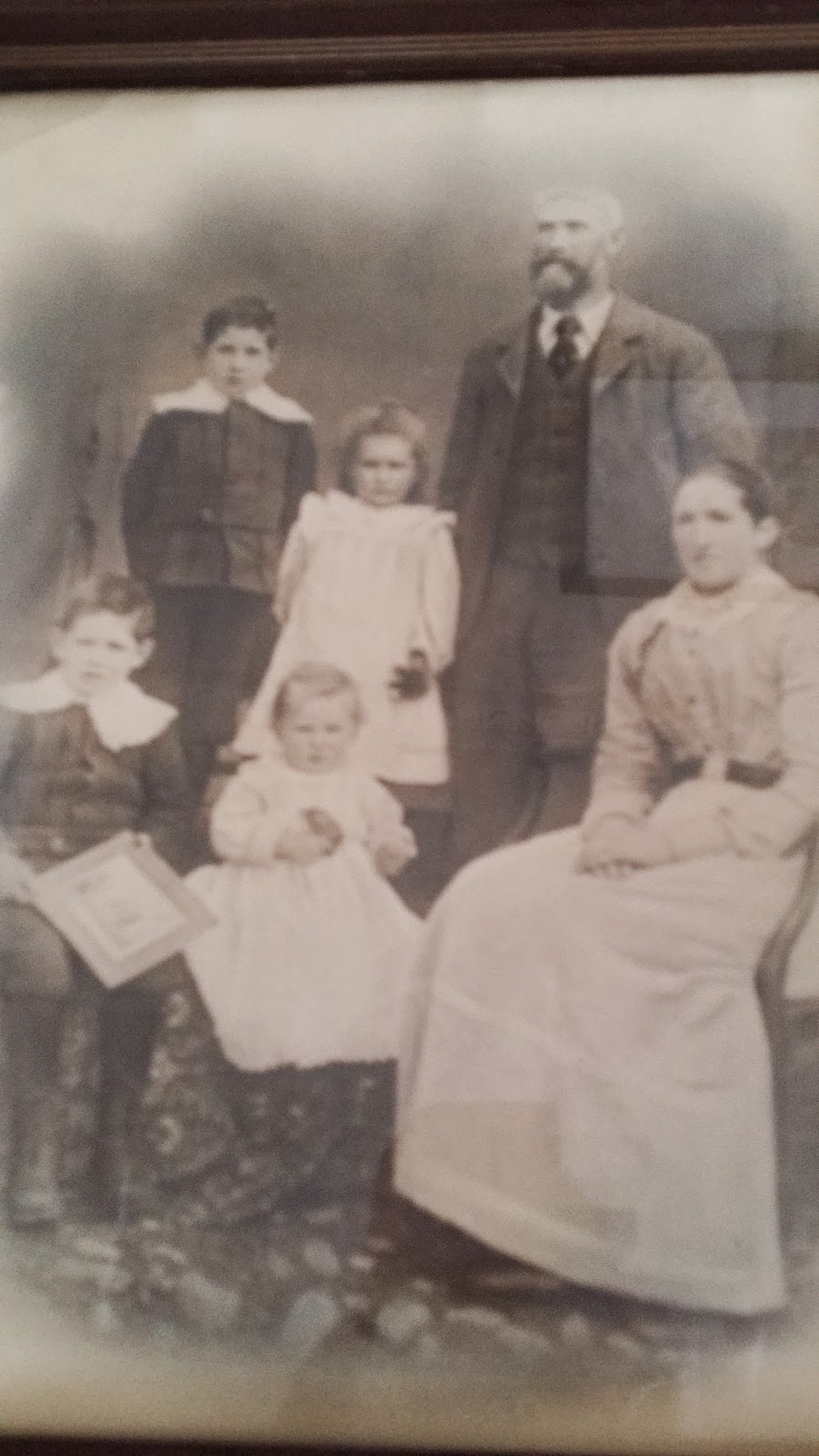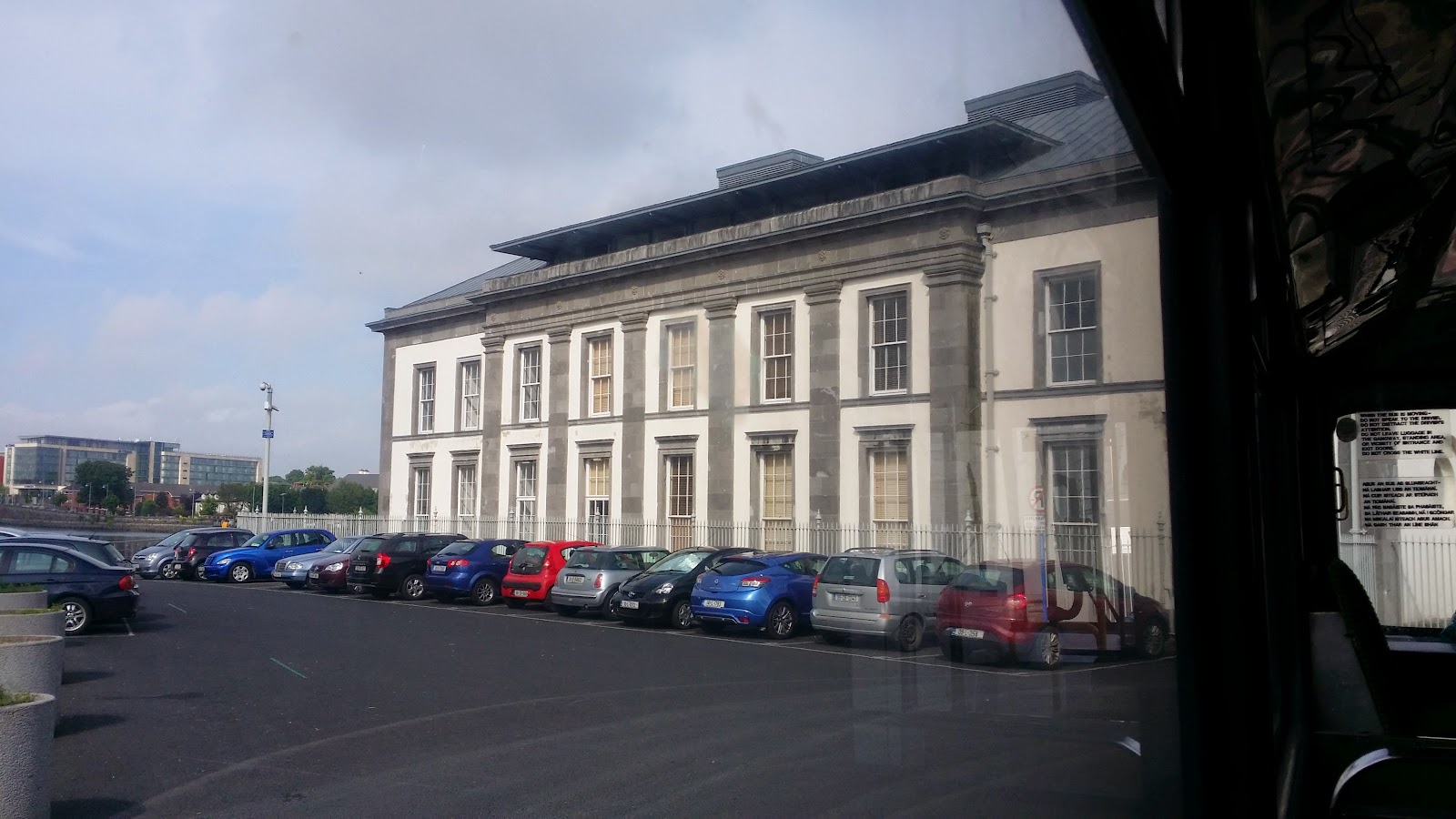As Dublin has a great ring road all around the city, with roads radiating to major cities, and has a tunnel through the centre which cost 10 euro up to 10.00am but only 3 euro afterwards, Heidi tried to take us into the Dublin where we knew the traffic to be very heavy due to roadworks. They have a water shortage here, no not an Irish story, but for real. The underground pipes leak millions of gallons of water, so they are being replaced and while they do that they are extending the light rail system.
I managed to get us onto the ring road, and we headed towards Limerick. But given that it is about 2.5 hours drive, we had to have some diversions. Firstly we went to find Mary's family in Boston. Blink and you will miss it, as Boston is really home to the Boston Manor. The owner of this land owned all the land as far as we could see. Ask a local when in doubt, and you get the answers! More about our Irish ancestors later, as we certainly had some lessons in history today!
 |
| We are parked in the entrance to one of the properties next door to Boston Manor |
 |
| Very peaceful farmland, lot of sheep and high tenstile power lines |
After getting back on the highway we headed towards the general area of Limerick, but our aim was to be in Boris on Ossory, where my grandfather's parents were married. But instead we tried to find the Rock of Dunamase. We thought then it was an old Irish burial ground. But the turnoff we took didn't pass the rock, and eventually we ended up in a small town Stradbally. The information board showed us the direction of Boris on Ossory, as Heidi couldn't find it.
Coffee in the village, and I happened to ask if there were any families named Simpson in the general area. Yes she says go back up the street to the Gala shop run by the Simpsons. So I did, and couldn't believe it when Ann Simpson told me her husband was David Simpson and the family name was from Scotland.
She even took us to her home and showed us a portrait of George Simpson and his family, another bit of my puzzle that I will have to research when I get home. Ann's husband died 14 years ago, and they bought the shop before he died so that she could have a business which allowed her to be home with the children. She certainly has a successful shop given the number of people who visited while we were there.
 |
| Young George Simpson who went to Canada, Mary (Molly) her dad George William Simpson wife Christina Patterson, then John and Charles. Charles lived in Kilkenny and had two boys Alex and George, George was David Simpson's father. The family came from Scotland, and that answered a lot of questions for me! After all Simpson, King and Buchanan are hardly Irish names! |
We then drove to Boris on Ossory. First though, we managed to find the Rock of Dumase. Not quite a rock but a whole abandoned castle on top of a rock!
Boris on Ossory is another almost blink and you will miss it but it had a Church of Ireland, which I presume was were my grandparents were married, cause they weren't Catholic!
Lunch in Sal's Diner, 10 euros well spent, and we set out for Limerick, but this time we took a detour to the Donaghmore Workhouse Museum. Never heard of it, had no idea what it was all about, but after an hour there, we learnt so much about the times that our grandparents left for Australia.
I now have a very different perspective on those difficult times. Basically the Catholic were not allowed to own any land, and the lands were owned by the wealthy, who lived in England, and had middlemen looking after their affairs. They charged the farmers rent and allowed them around 1000 sm of land (1/4 acre) on which they had to grow their crops in order to live and to pay rent. Their housing was similar to the crofters cottages in Scotland, and if they failed to pay the absorbently high rents, they were evicted and the landowner removed the shack.
Then came the Potato Famine. For those with Irish ancestors, I would encourage you to look up what is written in Wikipedia about the Potato Famine, and the Poor Law that was in place. The major cause of death in the times of the famine was typhus, from the lice along with all the other diseases that are caused by very poor living standards and no sanitary services.
Our tour guide was very informative, and we came away fascinated. How did they get to Australia, and Canada and the US? There were, at any one time over 250,000 people in the Workhouses. 2,500 died every week, and there were more than 100 workhouses across the country, one in each local area.
The landowners had to contribute to the Poor Tax, and funds from this paid in some cases, for the passage abroad. For others, they had relatives living abroad who sponsored them and, who used to send money back to their Irish relatives, and for some, the Australian government paid the way of unmarried girls so they could be employed as housemaids. If we thought the convicts had it tough, these poor people had it just as bad. The men and women were separated, as were the boys and girls, in fact children as young as 2 lived in the quarters with those up to 15. Just horrible. They were made to work, they had wooden slabs and a bag to sleep on, there was no heating, and when they arrived all their clothing was removed.
So now I know that perhaps my relatives, not being Catholic, might have had it a bit easier, they came because they were sponsored, and that is on their shipping records.
But for Mary's family, thank their lucky stars that they got to come to Australia, because they could have very well have ended up in this situation.
 |
| The bedding for the boys |
 |
| Men's quarters |
 |
| After WWI the workhouse was used as a billet for the Black and Tans, those British and Scottish forces who were supposed to be keeping the peace, this graffiti is written by a Scottish soldier, who had been in WWI, and they put up a Roll of Honour for those who died. But this strong room probably saw many other bad events. It was also where the records were kept. Hidden under lock and key, because the manager never wanted the public to know what had happened in the Workhouses. Some records may have survived, but some days the roads leading into the place were piled with bodies, as so many people just perished. |
 |
This is hard to even decipher, but the whole of Ireland was originally divvied up between the upper class, and the towns built up around the estates. Some Lords had 60000 acres of land.
After the soldiers left in 1923 it became a co-op for the butter industry, as the landowners, after the potato blight, concentrated on larger farms where they could raise cattle.
There is quite a collection of old equipment which John's grandparents would have used on their dairy farm.




They wouldn't have used this though, as measure to pour the Guinness

Another chance discovery and we really left with a much clearer understanding of what life was like for those caught in the terrible Famine. 1 million emigrated, and thank goodness they did!
Our B&B is the cheapest yet, and for the 65 euros, is quite good. No stairs is a bonus, the rooms spacious and this place could hold it's own with some higher priced B&B's we have been in.
Dinner at a small pub in the next village, next to a River. Note that they can only catch 10 salmon in the season!
Don't know how that is policed.
All in all we had an interesting day. bit luckier than the poor guy whose car was burning on the N7 this morning!
|
















































































